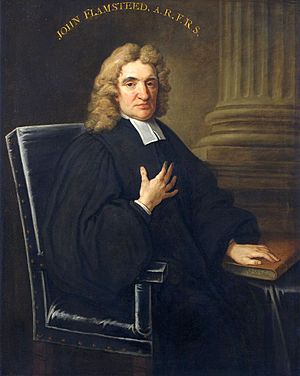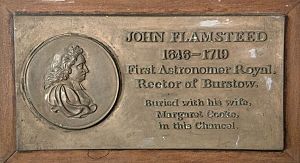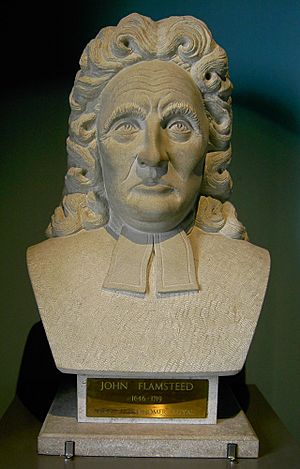John Flamsteed facts for kids
Quick facts for kids
John Flamsteed
|
|
|---|---|

Portrait by Thomas Gibson, 1712
|
|
| Born | 19 August 1646 Denby, Derbyshire, England
|
| Died | 31 December 1719 (aged 73) Burstow, Surrey, England
|
| Alma mater | Jesus College, Cambridge |
| Known for | First Astronomer Royal |
| Spouse(s) | Margaret Cooke |
| Scientific career | |
| Fields | Astronomy |
| Influences | Giovanni Battista Riccioli |
| Influenced |
|
John Flamsteed (born August 19, 1646 – died December 31, 1719) was a famous English astronomer. He was also the very first Astronomer Royal, a special job given by the King.
He is best known for creating a huge list of 3,000 stars, called Catalogus Britannicus. He also made a star map book called Atlas Coelestis. Both of these were published after he died. He was the first person to record seeing the planet Uranus, though he thought it was just another star at the time. He also helped start the famous Royal Greenwich Observatory.
Contents
Early Life and Education
Flamsteed was born in Denby, Derbyshire, England. He was the only son of Stephen Flamsteed and Mary Spadman. He went to school in Derby, where he learned Latin. Latin was very important for reading science books back then. He also loved history.
He had poor health for many years, which delayed his studies at Jesus College, Cambridge. During this time, he helped his father's business. He also became very interested in mathematics and astronomy.
In 1662, he was fascinated by an old book called De sphaera mundi. He then saw his first partial solar eclipse. This made him even more excited about space. He also learned about making sundials. He read books by famous astronomers like Jeremiah Horrocks. Horrocks' work greatly impressed Flamsteed.
In 1665, when he was 19, Flamsteed wrote his first astronomy paper. It was about how to design and use a special tool called a quadrant.
Becoming the Astronomer Royal
In 1670, Flamsteed went to Cambridge. He was there for two months in 1674. During this time, he heard lectures from the famous scientist Isaac Newton.
Flamsteed was planning to become a priest in Derbyshire. But then, Jonas Moore, a powerful person, invited him to London. Moore wanted to build an observatory.
King Charles II became interested in finding a way to figure out longitude at sea. This was very important for ships. The King set up a group of experts to look into new ideas. Flamsteed joined this group. He provided his own observations and ideas.
The group decided that a new observatory was needed. They also said an observer should be appointed. This person would map the stars and the Moon's movements. This would help sailors find their way.
On March 4, 1675, King Charles II officially appointed Flamsteed. He became "The King's Astronomical Observator." This made him the first English Astronomer Royal. His job was to "correct the Tables of the motions of the Heavens, and the places of the fixed stars." This would help "perfect the Art of Navigation."
In June 1675, the King ordered the building of the Royal Greenwich Observatory. Flamsteed himself laid the first stone on August 10.
In February 1676, he became a member of the Royal Society. This is a very old and respected group of scientists. He moved into the Observatory in July. He lived there until 1684. Then, he became a priest and moved to the village of Burstow in Surrey. He held both jobs until he died.

Flamsteed was buried in Burstow. His wife, Margaret, later asked to be buried in the same grave. She also wanted a special stone to remember him. However, this stone was never made. Almost 200 years later, a plaque was placed to mark his burial spot.
After he died, his wife kept his papers and tools. The papers were returned later, but his scientific tools were lost.
Important Discoveries

Flamsteed was very good at calculating solar eclipses. He correctly predicted the eclipses of 1666 and 1668.
He was also one of the first people to see the planet Uranus. He saw it in December 1690. However, he thought it was just a regular star. He even listed it in his catalogue as '34 Tauri'. This was the earliest known sighting of Uranus by an astronomer.
In 1672, Flamsteed measured the distance to Mars. He used special tools to see how Mars seemed to shift in the sky. This helped him figure out the distance to Mars and the astronomical unit.
In 1680, Flamsteed recorded a star called 3 Cassiopeiae. Later astronomers could not find this star. Some historians think he might have seen a supernova. A supernova is a huge star explosion. This event would have left behind a strong radio source called Cassiopeia A. However, the exact location and timing don't perfectly match. So, some people think he might have just made a mistake in recording a known star.
In 1681, two large comets were seen. Flamsteed believed they were actually the same comet. He thought it was traveling towards the Sun and then away from it. At first, Isaac Newton disagreed. But later, Newton agreed with Flamsteed. Newton then developed his idea that comets move around the Sun in large, oval-shaped paths.
Star Catalogue and Legacy
As Astronomer Royal, Flamsteed spent about 40 years carefully observing and recording stars. He wanted to create a very accurate star catalogue. His work would eventually list three times more stars than Tycho Brahe's old sky map.
Flamsteed was very careful. He didn't want to release any information that wasn't perfect. So, he kept his unfinished records locked up. In 1712, Isaac Newton, who was then the head of the Royal Society, and Edmond Halley got hold of Flamsteed's data without his permission. They published a star catalogue using his information. Flamsteed was very upset. He managed to get back most of the printed copies and burned them.
After Flamsteed died, his wife, Margaret, published his own version of Historia Coelestis Britannica in 1725. This book contained all of Flamsteed's careful observations. It listed 2,935 stars with much greater accuracy than any previous work. This was seen as the first major achievement of the Greenwich Observatory. The numbers used to identify stars in a later French edition are still used today. These are called Flamsteed designations.
In 1729, his wife also published his star map book, Atlas Coelestis. She had help from his assistants, Joseph Crosthwait and Abraham Sharp.
Honours and Memorials
- He became a Fellow of the Royal Society in 1677.
- The Flamsteed Astronomy Society is named after him. It is based at The Royal Observatory Greenwich.
- A crater on the Moon is named Flamsteed in his honour.
- The asteroid 4987 Flamsteed is also named after him.
- Several schools in Derbyshire remember him. The science building at John Port Spencer Academy is called Flamsteed. John Flamsteed Community School in Denby also carries his name. Flamsteed House at the Ecclesbourne School is named after him too.
- Derby City Council placed a Blue Plaque in his honour in Derby.
See also
 In Spanish: John Flamsteed para niños
In Spanish: John Flamsteed para niños
- Flamsteed objects
- 3 Cassiopeiae (a possible supernova sighting or recording error)

